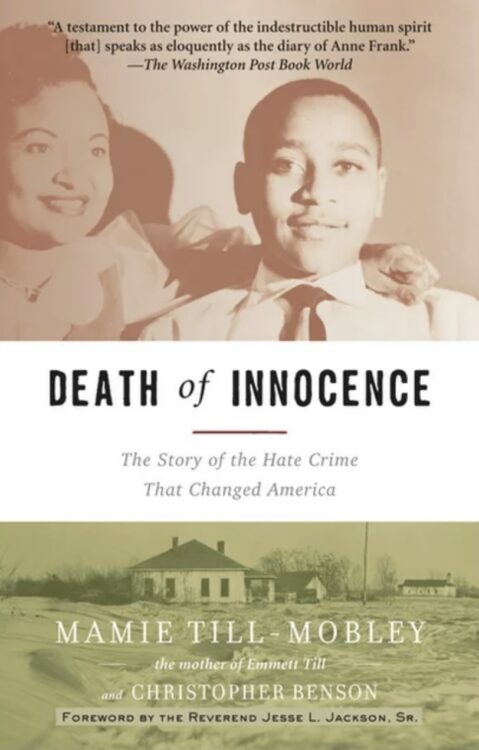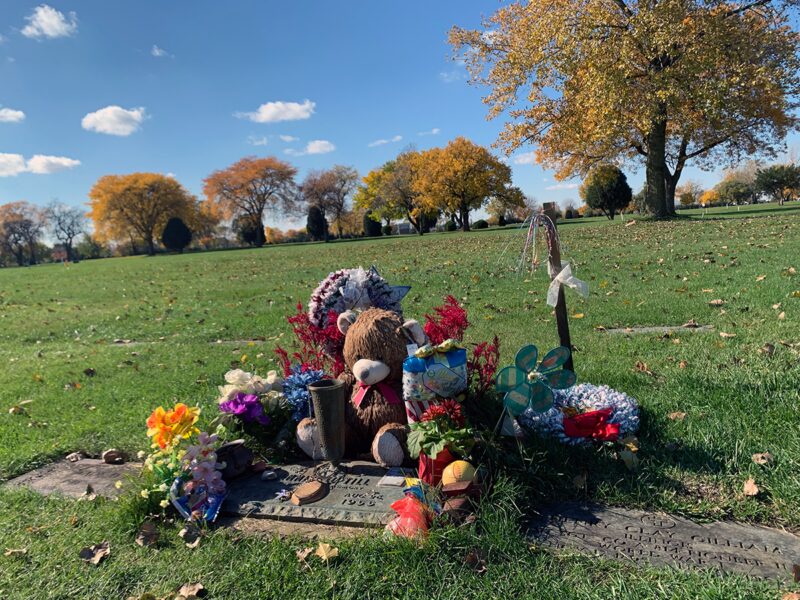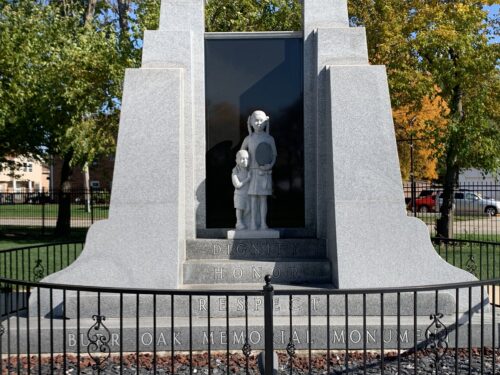A Mother’s Love
Share
Explore Our Galleries
Breaking News!
Today's news and culture by Black and other reporters in the Black and mainstream media.
Ways to Support ABHM?
Scholar-Griot: Samantha Humes, Attorney at Law
 America’s Black Holocaust Museum hosts a virtual book club. The book club pays tribute to the Museum’s founder, Dr. James Cameron, who was an avid reader and authored a powerful memoir chronicling his life as a survivor of a lynching. As a regular participant in the book club, I found myself particularly interested in a passage of a book read by the club called Death of Innocence: The Story of the Hate Crime that Changed America. This book tells the story of the life and murder of Emmett Till as told by his mother Mamie Till-Mobley. The passage of interest comes at the end of the book, on its very last page and reads:
America’s Black Holocaust Museum hosts a virtual book club. The book club pays tribute to the Museum’s founder, Dr. James Cameron, who was an avid reader and authored a powerful memoir chronicling his life as a survivor of a lynching. As a regular participant in the book club, I found myself particularly interested in a passage of a book read by the club called Death of Innocence: The Story of the Hate Crime that Changed America. This book tells the story of the life and murder of Emmett Till as told by his mother Mamie Till-Mobley. The passage of interest comes at the end of the book, on its very last page and reads:
With each day, I give thanks for the blessings of life – the blessings of another day and the chance to do something with it. Something good. Something significant. Something helpful. No matter how small it might seem. I want to keep making a difference. Although I am much more aware now of the limits of my own life, I am not afraid. My son has taught me so much about facing all aspects of life with courage. I have planned for the end of my life as carefully as I planned so much of the life I have lived recently. We have made arrangements with Mrs. Slivy Edmonds Cotton, president of Perpetua, Inc., the owners of Burr Oak Cemetery, for the establishment of a mausoleum and museum at the cemetery. Emmett, Gene [husband of Mamie Till-Mobley], and I will be there together with pictures and other remembrances of our lives in a setting that will enable children to learn. Not just about our history, but also about the transition in store for every life. The cemetery is for the living, after all, not the dead.
Emmett Till was murdered at the age of 14 in 1955 while visiting family in Mississippi. Emmett was accused of whistling at Carolyn Bryant, a white woman, working in her husband’s store. Soon after, the woman’s husband Roy Bryant and his half-brother John William Milam forcibly entered the home of Emmett’s uncle in the middle of the night while armed. The men kidnapped Emmett and beat, tortured, and murdered him. His bloated body was soon discovered in the Tallahatchie River. At trial, the two men were acquitted of Emmett’s murder by an all-white jury. Protected under the doctrine of double jeopardy, Roy Bryant and John William Milam later confessed to Emmett Till’s murder in interviews with Look magazine. The confessions were detailed by the magazine in an article titled The Shocking Story of Approved Killing in Mississippi published on January 24, 1956.
Emmett’s body was returned home to his mother in the Chicagoland area for burial. Her decision to have an open casket served as a watershed moment for the burgeoning Civil Rights Movement. Thousands came to view Emmett’s brutalized body which became a symbol of the utter viciousness of racial violence in America.
Reading Mamie Till-Mobley’s book, I understood that the Burr Oak Cemetery she wrote about was located just outside Chicago. A reasonable drive from America’s Black Holocaust Museum in Milwaukee, WI. I was disappointed that I wasn’t already aware of the mausoleum and museum she described, especially since I was reading her book almost 20 years after both its publication and her death. I began looking into Burr Oak Cemetery in Alsip, IL, and that is when I learned the heartbreaking and disturbing legacy of Burr Oak Cemetery.
Burr Oak Cemetery has a long history as a Black cemetery. It was established in 1927, and many distinguished and famous Black Americans have been buried there. Those buried in Burr Oak include notable athletes, musicians, singers, song writers, religious and civil rights leaders, businessmen and women, educators, attorneys, and many others. It is of course also the final resting place of Emmett Till, his mother, and Gene Mobley who married Emmett’s mother after Emmett’s death.
In July 2009, approximately 6 years after Mamie Till-Mobley’s death, Burr Oak Cemetery made local and national news due to a law enforcement investigation into a grave robbing scheme at Burr Oak. In the end, four cemetery workers were arrested and later convicted for their roles in the scam. The crimes involved digging up the bodies of people previously buried at the cemetery. Their remains were then unceremoniously discarded elsewhere on the cemetery property. Then the newly empty plots were re-sold for a profit. Carolyn Towns, a manager at the property received a prison sentence of 12 years. Maurice Dailey, a backhoe operator, received a probation term of 3 years. A foreman named Keith Nicks received a prison sentence of 6 years. The fourth cemetery worker, Terrence Nicks, received a prison term of 3 years.
ABC News covered the early developing story at the time with this news report.
Click on video to watch:
Because of greed and mismanagement, a significant number of people buried at the cemetery and their families have been harmed in a truly devastating manner. These criminal acts were callous beyond measure. A level of wickedness that defies explanation. The glass-top casket, that so famously displayed Emmett’s brutalized body in 1955, was found in a deplorable condition in a shed at Burr Oak Cemetery during the 2009 police investigation. The very casket that helped expose the barbarity of Emmett’s murder had been discarded and left to rot. In 2005, Emmett Till’s body had been exhumed as part of a federal criminal investigation and an autopsy performed. He was then reburied in a new casket, apparently due to an Illinois state law requirement. The purpose of the exhumation was to forensically confirm the body was indeed Emmett Till, since identification was a prominent issue during the trial of Bryant and Milam in 1955. This related to new efforts to prosecute Carolyn Bryant (now Carolyn Bryant Donham). Those efforts were unsuccessful, and she died in 2023.
I visited Burr Oak Cemetery in late 2023. Here are photos showing the gravesite of Emmett Till on the day of my visit on October 30, 2023.



Emmett Till gravesite photos taken by Samantha Humes, October 30, 2023
Mamie Till-Mobley had a vision and purpose in mind for Emmett’s final resting place. However, no mausoleum or museum for Emmet Till exists at Burr Oak. Whatever arrangements made with Burr Oak Cemetery all those years ago by Mamie Till-Mobley remain unfulfilled.
It may appear without question that this sequence of events has only a sorrowful and discouraging ending. Some wrongs are so destructive that righting those wrongs undoubtedly seems impossible. However, Mamie wrote that Emmett taught her about facing all aspects of life with courage. When justice is either denied or delayed, Black resilience is potent and inspiring. Mamie Till-Mobley understood that the history of both racial violence and Black resilience in America must be widely known and shared. Because of a mother’s love, it is unacceptable to just forget. And so, making sure we do not forget might be the true ongoing legacy of Emmett Till, Mamie Till-Mobley, and the Burr Oak Cemetery.
In furtherance of this notion are the following developments:
- In 2014, a monument was resurrected at the entrance to Burr Oak Cemetery. Its purpose was to acknowledge the most recent problematic history of the cemetery. The monument is inscribed with these words: Dignity, Honor, and Respect. A plaque further reads: This monument is dedicated to those souls disturbed during turbulent times. May they all rest in peace with the dignity, honor and respect they deserve, knowing they are loved and remembered forever



Burr Oak Monument photos taken by Samantha Humes, October 30, 2023
- Emmett Till’s glass-top coffin is now in the possession of the National Museum of African American History and Culture located in Washington, D.C. This museum is part of the Smithsonian system. The coffin was donated by Emmett Till’s family so that it could be preserved and serve to both educate and tell the story of Emmett Till.
- On March 29, 2022, President Biden signed into law the Emmett Till Anti-Lynching Act. Dating back to 1900, all previous attempts to pass federal anti-lynching legislation have failed. This new law makes lynching a hate crime under federal law and carries a maximum penalty of 30 years imprisonment.
- In December 2022, Emmett and Mamie were posthumously awarded the Congressional Gold Medal with the passage of the Emmett Till and Mamie Till-Mobley Congressional Gold Medal Act of 2021. This is the highest civilian honor that Congress bestows. The medal is to be on display alongside Emmett’s glass-top casket at the National Museum of African American History and Culture.
- On July 25, 2023, President Biden signed a proclamation establishing the Emmett Till and Mamie Till-Mobley National Monument. This new national monument will have locations both in Illinois and Mississippi and be managed by the National Park Service.
CBS News covered this development, and the video can be watched here. Please be advised the video does contain some graphic content.
The book club for America’s Black Holocaust Museum meets virtually on a regular basis. See the Events tab on the website for the America’s Black Holocaust Museum for book details and registration for upcoming meetings.
Samantha Humes is a graduate of Indiana University and the University of Wisconsin Law School. She has specialized in criminal defense for 20+ years, mostly representing the indigent. She most recently has expanded into immigration and Afghan asylum work. She calls Wisconsin home.









Comments Are Welcome
Note: We moderate submissions in order to create a space for meaningful dialogue, a space where museum visitors – adults and youth –– can exchange informed, thoughtful, and relevant comments that add value to our exhibits.
Racial slurs, personal attacks, obscenity, profanity, and SHOUTING do not meet the above standard. Such comments are posted in the exhibit Hateful Speech. Commercial promotions, impersonations, and incoherent comments likewise fail to meet our goals, so will not be posted. Submissions longer than 120 words will be shortened.
See our full Comments Policy here.